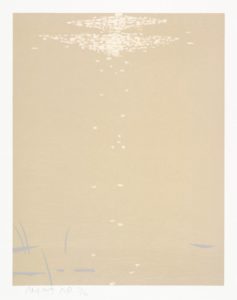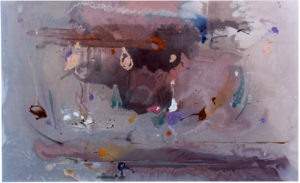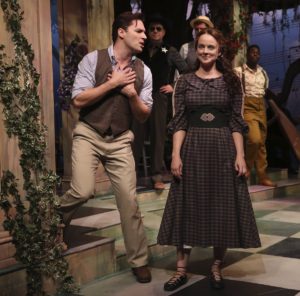 “Hollywood money isn’t money. It’s congealed snow, melts in your hand, and there you are.”
“Hollywood money isn’t money. It’s congealed snow, melts in your hand, and there you are.”
Dorothy Parker, interviewed by Marion Capron (Paris Review, Summer 1956)
Terry Teachout on the arts in New York City
 It doesn’t happen all that often these days, but I found myself home alone in New York last Friday night. Mrs. T was in Connecticut. I had no show to see that evening, nor was a pressing deadline hanging over my head, so I sent out for sushi, read a novel while I ate it, watched a movie I’d seen a half-dozen times before, lit a candle and watched it burn, and enjoyed the pleasant sensation of having nothing in particular to do.
It doesn’t happen all that often these days, but I found myself home alone in New York last Friday night. Mrs. T was in Connecticut. I had no show to see that evening, nor was a pressing deadline hanging over my head, so I sent out for sushi, read a novel while I ate it, watched a movie I’d seen a half-dozen times before, lit a candle and watched it burn, and enjoyed the pleasant sensation of having nothing in particular to do.
As I walked into the kitchen to throw away an apple core, my eye happened to fall on one of the two dozen pieces of art that hang on the walls of our New York apartment, Alex Katz’s “Northern Landscape (Bright Light),” a delicate print made in 1992 that bears a striking resemblance to a Japanese woodcut. “Bright Light” is so soft-spoken that it doesn’t make much of an impression at first glance, and even though I pass by whenever I go into or leave the kitchen, I tend not to look at it anymore. For some reason, though, “Bright Light” caught my eye that night, and all at once it came to life and filled my heart with unexpected joy.
A year after I started collecting art in 2003, I wrote an essay in which I observed that “the only good reason to buy a piece of art” is “so that you can look at it every day, as often as you want.” Nowadays I’d put the same thought somewhat differently: the wonderful thing about living in an apartment full of art is that you are constantly re-encountering it. Sometimes—fairly often, truth to tell—I’m too distracted to think more than casually, if at all, about what I’m seeing, but the art is always there, waiting to be noticed, and sooner or later I notice it.
 Mrs. T and I have chosen the pieces that we own with great care, and so far none of them has “gone dead on the wall,” as longtime collectors say. While we each have our particular favorites, I can honestly say that I love every work in our collection. That doesn’t mean, however, that I look at each and every piece whenever I’m home. A few of our prints, Helen Frankenthaler’s “Grey Fireworks” in particular, are so large and spectacular that they’re hard not to notice, while others, like “Northern Landscape (Bright Light),” are easy to overlook, rather like a shy child who never speaks up in class. And you know what? It doesn’t matter, not in the least.
Mrs. T and I have chosen the pieces that we own with great care, and so far none of them has “gone dead on the wall,” as longtime collectors say. While we each have our particular favorites, I can honestly say that I love every work in our collection. That doesn’t mean, however, that I look at each and every piece whenever I’m home. A few of our prints, Helen Frankenthaler’s “Grey Fireworks” in particular, are so large and spectacular that they’re hard not to notice, while others, like “Northern Landscape (Bright Light),” are easy to overlook, rather like a shy child who never speaks up in class. And you know what? It doesn’t matter, not in the least.
All this puts me in mind of a poem by W.H. Auden that has deep personal meaning for me:
Looking up at the stars, I know quite well
That, for all they care, I can go to hell,
But on earth indifference is the least
We have to dread from man or beast.
How should we like it were stars to burn
With a passion for us we could not return?
If equal affection cannot be,
Let the more loving one be me.
Like Auden, I’ve loved that way in the past, and I’m glad I don’t anymore. I’m glad, too, that the “stars” on the wall of our apartment are indifferent to the pleasure that they give, and to the mysterious fact that some of them give it more freely than others. When you live with art, it’s perfectly all right, even inevitable, that you’ll take it for granted from time to time. The art doesn’t care. It just is.
In today’s Wall Street Journal drama column I review the Broadway transfer of Natasha, Pierre & the Great Comet of 1812, directed by Rachel Chavkin. Here’s an excerpt.
* * *
Immersive theater is, we’re assured, the irresistible panacea that will inspire millennials to put down their smartphones and come charging into theaters at last…but what is it? As most people now use the phrase, immersive theater (which has actually been around forever—that’s how Harold Prince staged “Candide” on Broadway in 1974) jettisons the traditional actors-here-audience-there paradigm, replacing it with an in-your-face style in which the audience is invited to participate in the action of the show. Take “Natasha, Pierre & the Great Comet of 1812,” Dave Malloy’s musical version of part of Leo Tolstoy’s “War and Peace,” which has moved to Broadway in a scaled-up version starring Josh Groban. To make it immersive, the Imperial Theatre, a 1,400-seat proscenium-arch house, has been transformed by Mimi Lien, the scenic designer, into a fancy-tacky Russian nightclub with onstage cabaret seating for 200 and a series of ramps that let the cast wander at will among the rest of the audience….
 For all its explosive liveliness, Ms. Chavkin’s staging looks like a hopped-up concert version of a musical, not a bonafide Broadway show, and it serves mainly to paper over the essentially undramatic nature of “The Great Comet,” which feels less like an opera than a cantata—or, rather, a novel sung out loud. Large chunks of the unrhymed text come directly from Tolstoy’s book, and the characters spend most of their onstage time telling us what’s happening and how they feel about it instead of showing us. This impression is reinforced by Mr. Malloy’s songs, whose “tunes” are flattened-out non-melodies that exist only to carry the relentlessly wordy text and are superimposed on riffy vamps and short, oft-repeated harmonic cells. If that suggests minimalism, there’s a reason: Much of “The Great Comet” sounds quite a bit like what I imagine Philip Glass might have written had he decided to be a pop singer-songwriter, not a classical composer….
For all its explosive liveliness, Ms. Chavkin’s staging looks like a hopped-up concert version of a musical, not a bonafide Broadway show, and it serves mainly to paper over the essentially undramatic nature of “The Great Comet,” which feels less like an opera than a cantata—or, rather, a novel sung out loud. Large chunks of the unrhymed text come directly from Tolstoy’s book, and the characters spend most of their onstage time telling us what’s happening and how they feel about it instead of showing us. This impression is reinforced by Mr. Malloy’s songs, whose “tunes” are flattened-out non-melodies that exist only to carry the relentlessly wordy text and are superimposed on riffy vamps and short, oft-repeated harmonic cells. If that suggests minimalism, there’s a reason: Much of “The Great Comet” sounds quite a bit like what I imagine Philip Glass might have written had he decided to be a pop singer-songwriter, not a classical composer….
Minimalism mostly bores me, but there’s more than one way to write a show, and I freely acknowledge the extreme cleverness and originality of “The Great Comet.” I just wish it didn’t seem at least 45 minutes longer than it really is.
* * *
Read the whole thing here.
“What Is the Comet,” a short documentary film about Natasha, Pierre & the Great Comet of 1812:
 Howard Lindsay and Dorothy Stickney appear in a scene from Life With Father, a play adapted by Lindsay and Russel Crouse from Clarence Day’s autobiographical essays. The scene is introduced by Oscar Hammerstein II. Lindsay and Stickney created the roles of Father and Vinnie in the original production of the play, directed by Bretaigne Windust, which opened in New York in 1939 and ran for 3,224 performances, making it the longest-running straight play in the history of Broadway. This performance was originally seen on The Ford 50th Anniversary Show, directed by Jerome Robbins and simulcast by CBS and NBC on June 15, 1953:
Howard Lindsay and Dorothy Stickney appear in a scene from Life With Father, a play adapted by Lindsay and Russel Crouse from Clarence Day’s autobiographical essays. The scene is introduced by Oscar Hammerstein II. Lindsay and Stickney created the roles of Father and Vinnie in the original production of the play, directed by Bretaigne Windust, which opened in New York in 1939 and ran for 3,224 performances, making it the longest-running straight play in the history of Broadway. This performance was originally seen on The Ford 50th Anniversary Show, directed by Jerome Robbins and simulcast by CBS and NBC on June 15, 1953:
(This is the latest in a series of arts-related videos that appear in this space each Monday, Wednesday, and Friday)
 “What shouldn’t you do if you’re a young playwright? Don’t bore the audience! I mean, even if you have to resort to totally arbitrary killing on stage, or pointless gunfire, at least it’ll catch their attention and keep them awake. Just keep the thing going any way you can.”
“What shouldn’t you do if you’re a young playwright? Don’t bore the audience! I mean, even if you have to resort to totally arbitrary killing on stage, or pointless gunfire, at least it’ll catch their attention and keep them awake. Just keep the thing going any way you can.”
Tennessee Williams (interviewed by Dotson Rader in The Paris Review, Fall 1981)
Here’s my list of recommended Broadway, off-Broadway, and out-of-town shows, updated weekly. In all cases, I gave these shows favorable reviews (if sometimes qualifiedly so) in The Wall Street Journal when they opened. For more information, click on the title.
BROADWAY:
• An American in Paris (musical, G, too complex for small children, closes Jan. 1, reviewed here)
• The Color Purple (musical, PG-13, some performances sold out last week, reviewed here)
• The Encounter (one-man immersive drama, PG-13, many performances sold out last week, closes Jan. 8, reviewed here)
• Hamilton (musical, PG-13, Broadway transfer of off-Broadway production, all performances sold out last week, reviewed here)
• Matilda (musical, G, closes Jan. 1, reviewed here)
• On Your Feet! (jukebox musical, G, reviewed here)
OFF BROADWAY:
• The Fantasticks (musical, G, suitable for children capable of enjoying a love story, reviewed here)
 • Finian’s Rainbow (small-scale musical revival, G, extended through Dec. 31, reviewed here)
• Finian’s Rainbow (small-scale musical revival, G, extended through Dec. 31, reviewed here)
• Love, Love, Love (serious comedy, PG-13, closes Dec. 18, reviewed here)
CLOSING SOON OFF BROADWAY:
• Plenty (drama, PG-13, closes Dec. 1, reviewed here)
• Sweat (drama, PG-13, extended through Dec. 18, reviewed here)
CLOSING NEXT WEEK OFF BROADWAY:
• The Roads to Home (drama, G/PG-13, not suitable for children, closes Nov. 27, reviewed here)
| M | T | W | T | F | S | S |
|---|---|---|---|---|---|---|
| 1 | 2 | 3 | 4 | |||
| 5 | 6 | 7 | 8 | 9 | 10 | 11 |
| 12 | 13 | 14 | 15 | 16 | 17 | 18 |
| 19 | 20 | 21 | 22 | 23 | 24 | 25 |
| 26 | 27 | 28 | 29 | 30 | 31 | |
An ArtsJournal Blog